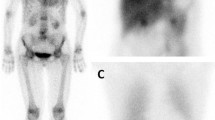Abstract.
Familial amyloid polyneuropathy (FAP) is a rare and severe hereditary form of amyloidosis, due to nervous deposits of a genetic variant transthyretin produced by the liver and characterized by both sensorimotor and autonomic neuropathy. Left ventricular systolic dysfunction is rare, but conduction disturbances and sudden deaths can occur. The neurological status of the heart has not been elucidated, and an alteration of the sympathetic nerves may be involved. We studied 17 patients (42±12 years) before liver transplantation by iodine-123 metaiodobenzylguanidine (MIBG) scintigraphy, heart rate variability analysis, coronary angiography, radionuclide ventriculography, rest thallium single-photon emission tomography (SPET) and echocardiography. Coronary arteries, left ventricular systolic function and rest thallium SPET were normal in all patients. Only mild evidence of amyloid infiltration was found at echocardiographic examination. Cardiac MIBG uptake was dramatically decreased in patients compared with age-matched control subjects (heart-to-mediastinum activity ratio at 4 h: 1.36±0.26 versus 1.98±0.35, P<0.001), while there was no difference in MIBG washout rate. Heart rate variability analysis showed a considerable scatter of values, with high values in four patients despite cardiac sympathetic denervation as assessed by MIBG imaging. The clinical severity of the polyneuropathy correlated with MIBG uptake at 4 h but not with the heart rate variability indices. Cardiac MIBG uptake and the heart rate variability indices did not differ according to the presence or absence of conduction disturbances. Patients with FAP have sympathetic cardiac denervation as assessed by MIBG imaging despite a preserved left ventricular systolic function and cardiac perfusion, without correlation with conduction disturbances. Results of the heart rate variability analysis were more variable and this technique does not seem to be the best way to evaluate the extent of cardiac sympathetic denervation in FAP patients.
Similar content being viewed by others
Author information
Authors and Affiliations
Additional information
Received 19 October 1998 and in revised form 6 January 1999
Rights and permissions
About this article
Cite this article
Delahaye, N., Dinanian, S., Slama, M. et al. Cardiac sympathetic denervation in familial amyloid polyneuropathy assessed by iodine-123 metaiodobenzylguanidine scintigraphy and heart rate variability. Eur J Nucl Med 26, 416–424 (1999). https://doi.org/10.1007/s002590050406
Issue Date:
DOI: https://doi.org/10.1007/s002590050406




